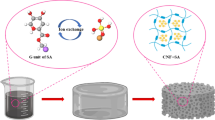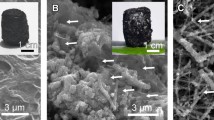Abstract
Solar-driven water evaporation is a sustainable solution for hypersaline water treatment, but salt accumulation on the evaporator surface seriously threatens the evaporation system longevity. Despite previous great efforts, critical challenges remain in preventing salt accumulation while maintaining a high evaporation rate. Herein, a salt-resistant three-dimensional carbon nanofiber/graphene oxide composite aerogel (CNF/GOA) with a high evaporation rate was designed. The introduction of GO dramatically enhanced the mechanical property of CNF/GOA and constructed abundant hierarchical interconnected channels for rapid water replenishment and salt diffusion. By suppressing heat conduction loss to bulk water and decreasing water evaporation enthalpy based on regulating the immersion depth and pore structure of CNF/GOA, an evaporation rate of 3.47 kg m−2 h−1 (3.5 wt% NaCl solution) was achieved under 1 sun irradiation (1 kW m−2). More importantly, hypersaline water evaporation (24.0 wt% NaCl brine and industrial hypersaline wastewater) without salt crystallization was achieved. The results of 24-h continuous testing and 10 cycles of 8-h testing proved that CNF/GOA possessed outstanding long-term stability. The outdoor evaporation experiment of the concentrated desulfurization wastewater exhibited a high evaporation rate (23.26 kg m−2 d−1, 7:00–17:00), indicating CNF/GOA had great practical application prospect. This work may offer a fascinating avenue towards practical hypersaline wastewater treatment.

摘要
太阳能蒸发是一种可持续的高盐废水处理技术, 然而运行中蒸发器表面的盐积累会严重缩短蒸发器的寿命. 如何使蒸发器兼具高蒸发效率和良好拒盐性是目前面临的挑战. 本研究设计了一种三维碳纳米纤维/氧化石墨烯复合气凝胶(CNF/GOA). 氧化石墨烯的引入不仅增强了CNF/GOA的力学性能, 同时构建了丰富的分级互连孔道结构, 加快了水的传输和盐的扩散, 实现了高蒸发速率和良好的拒盐性. 此外, 通过调控CNF/GOA的浸没深度和孔道结构, 抑制了水的热传导损失, 降低了水的蒸发焓, 在一个太阳照射下实现了3.47 kg m−2 h−1的蒸发速率. 更重要的是, 即使处理高盐水, 蒸发器表面也没有产生任何盐结晶. 长期实验和户外脱硫废水蒸发实验表明, CNF/GOA具有良好的实际应用前景.
Similar content being viewed by others
References
Zhang C, Shi Y, Shi L, et al. Designing a next generation solar crystallizer for real seawater brine treatment with zero liquid discharge. Nat Commun, 2021, 12: 998
Shuangchen M, Jin C, Gongda C, et al. Research on desulfurization wastewater evaporation: Present and future perspectives. Renew Sustain Energy Rev, 2016, 58: 1143–1151
Finnerty C, Zhang L, Sedlak DL, et al. Synthetic graphene oxide leaf for solar desalination with zero liquid discharge. Environ Sci Technol, 2017, 51: 11701–11709
Geng Y, Jiao K, Liu X, et al. Applications of bio-derived/bio-inspired materials in the field of interfacial solar steam generation. Nano Res, 2022, 15: 3122–3142
Wu P, Wu X, Wang Y, et al. Towards sustainable saline agriculture: Interfacial solar evaporation for simultaneous seawater desalination and saline soil remediation. Water Res, 2022, 212: 118099
He W, Zhou L, Wang M, et al. Structure development of carbon-based solar-driven water evaporation systems. Sci Bull, 2021, 66: 1472–1483
Han J, Xing W, Yan J, et al. Stretchable and superhydrophilic polyaniline/halloysite decorated nanofiber composite evaporator for high efficiency seawater desalination. Adv Fiber Mater, 2022, 4: 1233–1245
Chen J, Yin JL, Li B, et al. Janus evaporators with self-recovering hydrophobicity for salt-rejecting interfacial solar desalination. ACS Nano, 2020, 14: 17419–17427
Liu H, Gu J, Liu Y, et al. Reconfiguration and self-healing integrated Janus electrospinning nanofiber membranes for durable seawater desalination. Nano Res, 2023, 16: 489–495
Xia Y, Hou Q, Jubaer H, et al. Spatially isolating salt crystallisation from water evaporation for continuous solar steam generation and salt harvesting. Energy Environ Sci, 2019, 12: 1840–1847
Wang Y, Wu X, Wu P, et al. Salt isolation from waste brine enabled by interfacial solar evaporation with zero liquid discharge. J Mater Chem A, 2022, 10: 14470–14478
Hao L, Liu N, Niu R, et al. High-performance salt-resistant solar interfacial evaporation by flexible robust porous carbon/pulp fiber membrane. Sci China Mater, 2022, 65: 201–212
Gao T, Wang Y, Wu X, et al. More from less: Improving solar steam generation by selectively removing a portion of evaporation surface. Sci Bull, 2022, 67: 1572–1580
Zhou X, Zhao F, Guo Y, et al. Architecting highly hydratable polymer networks to tune the water state for solar water purification. Sci Adv, 2019, 5: eaaw5484
Lu Y, Fan D, Shen Z, et al. Design and performance boost of a MOF-functionalized-wood solar evaporator through tuning the hydrogen-bonding interactions. Nano Energy, 2022, 95: 107016
Zhao F, Zhou X, Shi Y, et al. Highly efficient solar vapour generation via hierarchically nanostructured gels. Nat Nanotech, 2018, 13: 489–495
Liu C, Hong K, Sun X, et al. An ‘antifouling’ porous loofah sponge with internal microchannels as solar absorbers and water pumpers for thermal desalination. J Mater Chem A, 2020, 8: 12323–12333
Chen Z, Li Q, Chen X. Porous graphene/polyimide membrane with a three-dimensional architecture for rapid and efficient solar desalination via interfacial evaporation. ACS Sustain Chem Eng, 2020, 8: 13850–13858
Wu D, Liang J, Zhang D, et al. Solar evaporation and electricity generation of porous carbonaceous membrane prepared by electrospinning and carbonization. Sol Energy Mater Sol Cells, 2020, 215: 110591
Dong X, Cao L, Si Y, et al. Cellular structured CNTs@SiO2 nanofibrous aerogels with vertically aligned vessels for salt-resistant solar desalination. Adv Mater, 2020, 32: 1908269
Zhao F, Guo Y, Zhou X, et al. Materials for solar-powered water evaporation. Nat Rev Mater, 2020, 5: 388–401
Lin YZ, Zhong LB, Dou S, et al. Facile synthesis of electrospun carbon nanofiber/graphene oxide composite aerogels for high efficiency oils absorption. Environ Int, 2019, 128: 37–45
Morciano M, Fasano M, Boriskina SV, et al. Solar passive distiller with high productivity and Marangoni effect-driven salt rejection. Energy Environ Sci, 2020, 13: 3646–3655
Fang Q, Li T, Lin H, et al. Highly efficient solar steam generation from activated carbon fiber cloth with matching water supply and durable fouling resistance. ACS Appl Energy Mater, 2019, 2: 4354–4361
Xu Y, Ma J, Han Y, et al. A simple and universal strategy to deposit Ag/polypyrrole on various substrates for enhanced interfacial solar evaporation and antibacterial activity. Chem Eng J, 2020, 384: 123379
Meng X, Xu W, Li Z, et al. Coupling of hierarchical Al2O3/TiO2 nanofibers into 3D photothermal aerogels toward simultaneous water evaporation and purification. Adv Fiber Mater, 2020, 2: 93–104
Guo Y, Yu G. Engineering hydrogels for efficient solar desalination and water purification. Acc Mater Res, 2021, 2: 374–384
Liu N, Hao L, Zhang B, et al. Rational design of high-performance bilayer solar evaporator by using waste polyester-derived porous carbon-coated wood. Energy Environ Mater, 2022, 5: 617–626
Yu Z, Gu R, Tian Y, et al. Enhanced interfacial solar evaporation through formation of micro-meniscuses and microdroplets to reduce evaporation enthalpy. Adv Funct Mater, 2022, 32: 2108586
Chen Y, Yang J, Zhu L, et al. An integrated highly hydrated cellulose network with a synergistic photothermal effect for efficient solar-driven water evaporation and salt resistance. J Mater Chem A, 2021, 9: 15482–15492
Zhang P, Liao Q, Yao H, et al. Three-dimensional water evaporation on a macroporous vertically aligned graphene pillar array under one sun. J Mater Chem A, 2018, 6: 15303–15309
Zhang X, Yang L, Dang B, et al. Nature-inspired design: p-Toluene-sulfonic acid-assisted hydrothermally engineered wood for solar steam generation. Nano Energy, 2020, 78: 105322
Hou Q, Xue C, Li N, et al. Self-assembly carbon dots for powerful solar water evaporation. Carbon, 2019, 149: 556–563
Bai H, Liu N, Hao L, et al. Self-floating efficient solar steam generators constructed using super-hydrophilic N,O dual-doped carbon foams from waste polyester. Energy Environ Mater, 2022, 5: 1204–1213
Sun Z, Li W, Song W, et al. A high-efficiency solar desalination evaporator composite of corn stalk, Mcnts and TiO2: Ultra-fast capillary water moisture transportation and porous bio-tissue multi-layer filtration. J Mater Chem A, 2020, 8: 349–357
Kospa DA, Ahmed AI, Samra SE, et al. High efficiency solar desalination and dye retention of plasmonic/reduced graphene oxide based copper oxide nanocomposites. RSC Adv, 2021, 11: 15184–15194
Cui L, Zhang P, Xiao Y, et al. High rate production of clean water based on the combined photo-electro-thermal effect of graphene architecture. Adv Mater, 2018, 30: 1706805
Xu Y, Tang C, Ma J, et al. Low-tortuosity water microchannels boosting energy utilization for high water flux solar distillation. Environ Sci Technol, 2020, 54: 5150–5158
Guo Z, Zhou W, Arshad N, et al. Excellent energy capture of hierarchical MoS2 nanosheets coupled with MXene for efficient solar evaporators and thermal packs. Carbon, 2022, 186: 19–27
Zhou X, Zhao F, Guo Y, et al. A hydrogel-based antifouling solar evaporator for highly efficient water desalination. Energy Environ Sci, 2018, 11: 1985–1992
World Health Organization (WHO), Safe Drinking-Water from Desalination (WHO, 2011), http://apps.who.int/iris/bitstream/10665/70621/1/WHO_HSE_SHSH11.03_ngg.pdf
Surwade SP, Smirnov SN, Vlassiouk IV, et al. Water desalination using nanoporous single-layer graphene. Nat Nanotech, 2015, 10: 459–464
Acknowledgements
This work was financially supported by the Natural Science Foundation of Xiamen, China (502Z20227238), the National Natural Science Foundation of China (51978639, 22276181, and 52000167), the Youth Innovation Promotion Association CAS (2019307), the Talent Introduction Program of Postdoctoral International Exchange Program (110000A089), the STS Project of Science and Technology Program of Fujian Province, China (2021T3071), and the CAS Key Laboratory of Urban Pollutant Conversion Joint Research Fund (KLUPC-2021-1).
Author information
Authors and Affiliations
Contributions
Author contributions Zhong LB and Zheng YM designed the research project; Zhong LB and Chen SJ conducted the experiment; Zhang QJ did some characterizations; Guo CY performed the COMSOL simulation; Hou X performed some data analysis and offered helpful suggestions; Zhong LB, Zhang QJ and Zheng YM analyzed the data and wrote the paper. All authors contributed to the general discussion.
Corresponding author
Additional information
Conflict of interest The authors declare that they have no conflict of interest.
Supplementary information Supporting data are available in the online version of the paper.
Lu-Bin Zhong is currently an associate professor at the Institute of Urban Environment, Chinese Academy of Sciences (IUE, CAS). He received his PhD degree from Xiamen University in 2013. He joined IUE, CAS in 2013. His research interests include (1) the design and application of nanofiber membranes; and (2) the rapid detection of pollutants.
Yu-Ming Zheng is currently a professor at IUE, CAS. He received his PhD degree from the University of Science and Technology of China in 2006. From 2006 to 2012, he continued his research at the National University of Singapore. He joined IUE, CAS in 2012. His research interests include (1) membrane separation technology and membrane materials; and (2) adsorbents and catalytic functional materials.
Electronic supplementary material
40843_2022_2467_MOESM1_ESM.pdf
Salt-resistant carbon aerogel with hierarchical interconnected channels for continuous and efficient solar evaporation of hypersaline water
Rights and permissions
About this article
Cite this article
Zhong, LB., Chen, SJ., Hou, X. et al. Salt-resistant carbon aerogel with hierarchical interconnected channels for continuous and efficient solar evaporation of hypersaline water. Sci. China Mater. 66, 3300–3309 (2023). https://doi.org/10.1007/s40843-022-2467-x
Received:
Accepted:
Published:
Issue Date:
DOI: https://doi.org/10.1007/s40843-022-2467-x




